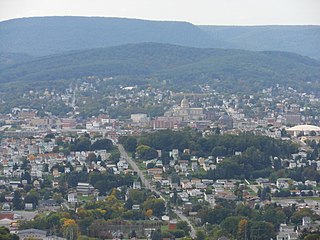
Altoona is a city in Blair County, Pennsylvania, United States. It is the principal city of the Altoona metropolitan statistical area (MSA). The population was 43,963 at the time of the 2020 census, making it the 18th most populous city in Pennsylvania. The Altoona MSA includes all of Blair County and was recorded as having a population of 122,822 at the 2020 Census, around 100,000 of whom live within a 5-mile (8.0 km) radius of the Altoona city center according to U.S. Census ZIP Code population data. This includes the adjacent boroughs of Hollidaysburg and Duncansville, adjacent townships of Logan, Allegheny, Blair, Frankstown, Antis, and Tyrone, as well as nearby boroughs of Bellwood and Newry.

Coatesville is a city in Chester County, Pennsylvania, United States. The population was 13,350 at the 2020 census. Coatesville is approximately 39 miles west of Philadelphia. It developed along the Philadelphia and Lancaster Turnpike beginning in the late 18th century. It spans U.S. Route 30, the "Main Line" highway that runs west of Philadelphia.

West Chester is a borough and the county seat of Chester County, Pennsylvania, United States. Located within the Philadelphia metropolitan area, the borough had a population of 18,461 at the 2010 census. West Chester is the mailing address for most of its neighboring townships. When calculated by mailing address, the population as of the 2010 U.S. Census was 108,696, which would make it the 10th largest city by mailing address in the state of Pennsylvania.
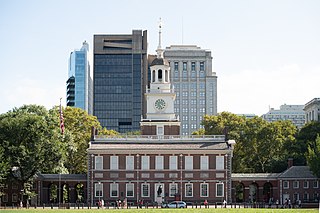
Independence Hall is a historic civic building in Philadelphia, where both the United States Declaration of Independence and the United States Constitution were debated and adopted by America's Founding Fathers. The structure forms the centerpiece of the Independence National Historical Park. Independence Hall was named to the National Register of Historic Places in 1966 and as a World Heritage Site in 1979.

Thomas Ustick Walter was an American architect of German descent, the dean of American architecture between the 1820 death of Benjamin Latrobe and the emergence of H.H. Richardson in the 1870s. He was the fourth Architect of the Capitol and responsible for adding the north (Senate) and south (House) wings and the central dome that is predominantly the current appearance of the U.S. Capitol building. Walter was one of the founders and second president of the American Institute of Architects. In 1839, he was elected as a member to the American Philosophical Society.

Independence National Historical Park is a federally protected historic district in Philadelphia, Pennsylvania that preserves several sites associated with the American Revolution and the nation's founding history. Administered by the National Park Service, the 55-acre (22 ha) park comprises many of Philadelphia's most-visited historic sites within the Old City and Society Hill neighborhoods. The park has been nicknamed "America's most historic square mile" because of its abundance of historic landmarks.

The Crozer Theological Seminary was a Baptist seminary located in Upland, Pennsylvania.

Downtown Cleveland is the central business district of Cleveland, Ohio. The economic and symbolic center of the city and the Cleveland-Akron-Canton, OH Combined Statistical Area, it is Cleveland's oldest district, with its Public Square laid out by city founder General Moses Cleaveland in 1796.

Samuel Sloan was a Philadelphia-based architect and best-selling author of architecture books in the mid-19th century. He specialized in Italianate villas and country houses, churches, and institutional buildings. His most famous building—the octagonal mansion "Longwood" in Natchez, Mississippi—is unfinished; construction was abandoned during the American Civil War.

Downtown San Diego is the city center of San Diego, California, the eighth largest city in the United States. In 2010, the Centre City area had a population of more than 28,000. Downtown San Diego serves as the cultural and financial center and central business district of San Diego, with more than 4,000 businesses and nine districts. The downtown area is the home of the San Diego Symphony and the San Diego Opera as well as multiple theaters and several museums. The San Diego Convention Center and Petco Park, home of the San Diego Padres, are also located downtown. Downtown San Diego houses the major local headquarters of the city, county, state, and federal governments.
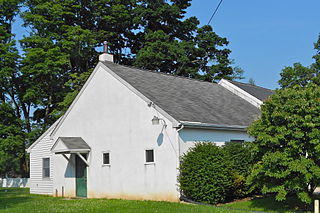
Ercildoun, population about 100, is an unincorporated community in East Fallowfield Township, Chester County, Pennsylvania, United States. The hamlet was founded by Quakers and was an early center of the abolitionist movement. In 1985 the entire hamlet, including 31 properties, was listed as a historic district on the National Register of Historic Places. Of these properties two were vacant land, 14 were significant buildings, ten were contributing buildings, and five buildings, built in the 1950s, were non-contributing. The Lukens Pierce House, an octagon house listed separately on the U.S. National Register of Historic Places, is located about half a mile northwest of the hamlet. Ercildoun is one of about ten hamlets in the township, which has no cities or towns, but has 31 sites listed on the National Register. It is one of the larger hamlets, located near the center of the township, and historically among the best known. The city of Coatesville is about 3 miles north.
Downtown Beaumont is the central business district of Beaumont, Texas. It is where the city's highrise buildings are located, as well as being the center of government and business for the region. Downtown Beaumont is currently experiencing a renaissance, with streets, sidewalks and historic buildings receiving significant attention.

Primitive Hall is a brick house built in 1738 in rural Chester County, Pennsylvania, United States, by Joseph Pennock. The house was occupied by his descendants until 1960, when it was donated to and restored by a foundation controlled by his descendants. The house was listed by the National Register of Historic Places in 1975.
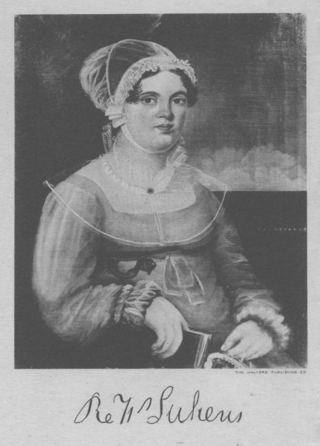
Rebecca Lukens (1794–1854), born Rebecca Webb Pennock, was an American businesswoman. She was the owner and manager of the iron and steel mill which became the Lukens Steel Company of Coatesville, Pennsylvania. Fortune Magazine called her "America's first female CEO of an industrial company" and its board of editors named her to the National Business Hall of Fame in 1994.

Chester Waterside Station of the Philadelphia Electric Company is a historic former coal-fired power station, located on the Delaware River in Chester, Delaware County, southeastern Pennsylvania.
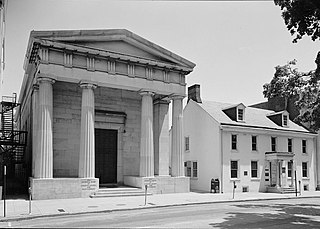
Bank of Chester County is a historic two-story bank building located in West Chester, Chester County, Pennsylvania, the first bank to be chartered in the county. Following the failure to renew the charter of the Bank of the United States in 1811, states received responsibility over the banking systems within their jurisdiction. Although an initial proposal was rejected by the state legislature in 1813, a 41-bank proposal was passed the following year. An early bank building was utilized in West Chester beginning in 1814 at the Record Office, though the bank was relocated in 1818 to a building across the street, present-day 13 High Street. Following a proposal for a new site in 1835, a bank, to be built at 17 High Street, designed by architect Thomas Ustick Walter (1804–1887). It was built in 1836 in the Greek Revival style at the cost of $33,000, and features a portico with four Doric order columns; the bank was subsequently altered in 1874, 1905, and 1928. The previous building has since been rented to numerous individuals, although it still houses outdated equipment no longer used by the bank. The current building is occupied by Wells Fargo.

West Chester Downtown Historic District is a national historic district located in West Chester, Chester County, Pennsylvania. It encompasses 3,137 contributing buildings in West Chester. It includes residential, commercial, institutional, and industrial buildings built between 1789 and the 1930s. Notable buildings include the U.S. Post Office, Green Tree Building (1933), St. Agnes Church (1851), Biddle Street School (1917), Major Groff Memorial Armory, Horticulture Building (1848) designed by Thomas U. Walter, Denney-Reyburn factory, Caleb Taylor Store, Federal Ehne's Bakery, Kofke's Store, and Woolworth (1928). Also listed and located in the district are the Bank of Chester County, Buckwalter Building, Chester County Courthouse, Farmers and Mechanics Building, and Warner Theater.
Mary B. Thistlethwaite Birdsall (1828–1894) was born in Pennsylvania to English immigrants. She grew up on a farm near Richmond, Indiana, where she married Thomas Birdsall in 1848. They had three sons together. She was a journalist, a suffragist, and a temperance worker. She began her journalism career as the woman's editor at the Indiana Farmer newspaper. For about five years she owned The Lily, a newspaper for women, which she purchased from suffragist Amelia Bloomer in 1854. She helped organize the second women's rights convention in Indiana. At that Indiana convention in 1852, she was elected as secretary for the newly-formed Indiana Woman's Rights Association (renamed the Indiana Woman's Suffrage Association in 1869, and eventually became president of the organization. Birdsall was a vice-president at the fourth National Women's Rights Convention in Cleveland, Ohio, in 1853. She was among the first three women to address the Indiana legislature in 1859 to present a women's rights petition, speaking for a half-hour in support of women's suffrage. Birdsall died in Philadelphia in 1894 and interred at Earlham Cemetery in Richmond. Her Richmond home, a model of progressive architecture as espoused by Catherine Beecher, was listed on the National Register of Historic Places in 1999.
Robert D. Lukens, Ph.D., was an American collection manager, historian and columnist. During his career, Lukens oversaw exhibitions at the United States Capitol Visitor Center in Washington D.C. He served as the President of the Chester County Historical Society from 2011 until 2015.

The Pennsylvania Woman's Convention at West Chester in 1852 was held in West Chester, Pennsylvania on June 2 and 3. The convention attracted many women's rights activists from around the United States. The convention discussed women's rights issues, including women's suffrage, equal pay, and equal access to education. The convention also addressed legal issues facing women. It was the first woman's rights convention held in Pennsylvania.


















